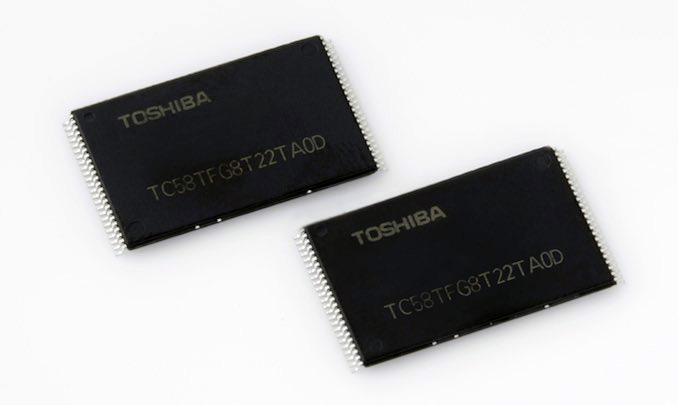Toshiba and SanDisk Announce 48-layer 256Gbit TLC 3D NAND
by Billy Tallis on August 4, 2015 11:00 AM EST
This week Toshiba and SanDisk are announcing a new milestone in their joint development of flash memory. Back in March Toshiba announced a 48-layer 3D NAND technology that they were sampling in the form of a 128Gb MLC die. Now Toshiba and partner SanDisk have built a 256Gb TLC die on their 48-layer process. Toshiba will be sampling that chip starting in September, and SanDisk has selected it as their first 3D NAND device for mass production.
Central to this development is the outfitting of Fab 2 at their facility in Yokkaichi, Japan. The previous Fab 2 was demolished in 2014 and construction started on a replacement to be used as their first fab for 3D NAND. The new Fab 2 has now started pilot production of 3D NAND as it is being readied for mass production, scheduled to begin in 2016. Toshiba says the fab will be completed in the first half of the year and SanDisk plans to be shipping products using their 3D NAND by the end of the year.
The new 3D NAND will face experienced competition from Samsung who are currently shipping 32-layer 3D NAND in capacities up to 128Gb for both MLC and TLC configurations. Samsung has also announced its third generation V-NAND which should be starting mass production in the latter half of this year. Meanwhile, Intel and Micron have stated that their 32-layer 3D NAND will be in mass production by the fourth quarter of this year in the form of a 256Gb MLC die and a 384Gb TLC die. SK Hynix is to begin mass production of a 36-layer 128Gb MLC die during the third quarter and is working toward a 48-layer TLC that will be available in 2016.
All of the major flash manufacturers have now publicized their plans for introducing 3D NAND. Planar NAND won't be disappearing overnight or even in a year, as it takes a lot of time and money to convert a fab to a new process. But from here on out, we can expect all the most interesting news about NAND flash memory to be about 3D.
Source: Toshiba & Sandisk










28 Comments
View All Comments
melgross - Tuesday, August 4, 2015 - link
I suspect that by the end of 2016, we'll find 1TB drives pushing $250, and 2TB drives pushing $475. Still much higher than HDDs, but low enough for many more people to come on board.yuhong - Tuesday, August 4, 2015 - link
And if that happens hopefully SSDs will be standard in OEM machines by then.mapesdhs - Thursday, August 6, 2015 - link
So much for SanDisk saying they wanted to produce 8TB SSDs within two years. Oh well.Aries1470 - Tuesday, August 11, 2015 - link
Theoretically, they can ;-) Price wise etc, um.. not sure.Dark_Archonis - Wednesday, August 5, 2015 - link
A ton of NAND and memory technology announcements occurring these days. I'd like to see more technology coming to market, instead of just announcements.Billy Tallis - Wednesday, August 5, 2015 - link
The industry is in the midst of the transition to 3D NAND, which is the most significant technology change that has occurred in the time that flash has been affordable enough for consumer applications. On a smaller timescale, Flash Memory Summit is next week. It's the time of year for announcements like this, just like you'd expect to see a lot of TV and video camera announcements around NAB Show.The Intel/Micron 3D XPoint announcement was pretty out of the blue, but I suspect they had wide leeway for when to announce it. They probably could have announced it this spring or this winter and it wouldn't have made much difference, but last week was when they could upstage the most stuff coming from their competitors.
at80eighty - Wednesday, August 5, 2015 - link
welcome to anandtech Billy - looking forward to more indepth articles soonSo last century - Saturday, August 8, 2015 - link
What's with all the drama in the comments section? SSDs are like the envious and weak siblings of 3d crosspoint we need more of them to take 3d xpoint down a peg or two in price. That or something similar or better in reliability and speed.